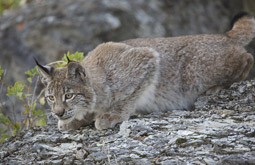The Canada Lynx
The lynx is a predator that belongs to the family of the felidae. Four different sub-species belong to the family of the lynx. One is the Canada lynx whose fur is mostly used by the fur industry. This lynx is found mainly in Canada and West-Montana. Smaller populations of lynx have also settled in other U.S. states.
The Canada lynx has a thick, yellowish-brown fur. Fur color may vary strongly from animal to animal. Shades of grey dominate the animal’s back. In the winter, the white ends of the back hair serves as camouflage, because it looks like snow. Canada lynx with black spots are very rare. In the nape area, the animal’s hair is longer, especially so in winter. The points of the cat’s triangular ears have white spots and end in the typical long tufts of hair allowing you to recognize lynx immediately. Lynx have short, black-ringed tails. Their large, hairy paws ensure an optimum spread of the animal’s weight while walking on snow, ensuring that they do not sink deeply into the snow. Body lengths vary between 60 and 120 cm, as does the weight of the individual animals (5 to 18 kg). Shoulder height can reach up to 75 cm.
Canada lynx preferably live in forests with dense underwood but can also be found in rocky terrain or Tundra landscapes. These predators are primarily active during the night and prefer to hide on cliff ledges, fallen trees or bushes during the day. Canada lynx are loners and avoid one another other except during mating season. Their territories range from 11 to 300 km². The territories of female lynx can overlap; whereas male territories often take up the entire territory of a female and her young.
Lynx are primarily visual hunters but they also have an excellent sense of hearing. They feed exclusively on meat, sneaking up on to their prey before pouncing on them. The Canada lynx’ most important prey are snowshoe rabbits. In certain regions, lynx feed on nothing else and therefore depend greatly on the availability of these rabbits. In other regions, the lynx feed on rodents, birds, and fish. In autumn and winter, they also kill deer or other hoofed animals weakened by the mating season.
Lynx mate between February and March. The females bear litters of two to three young after 8 to 10 weeks. The young are suckled for five months but are already able to feed on meat after only a month’s time. The male lynx is not involved in the upbringing of the young. The young lynx remain with their mother until the next mating season to gain hunting experience. Often, siblings continue to live together for some time after the separation from their mother.


